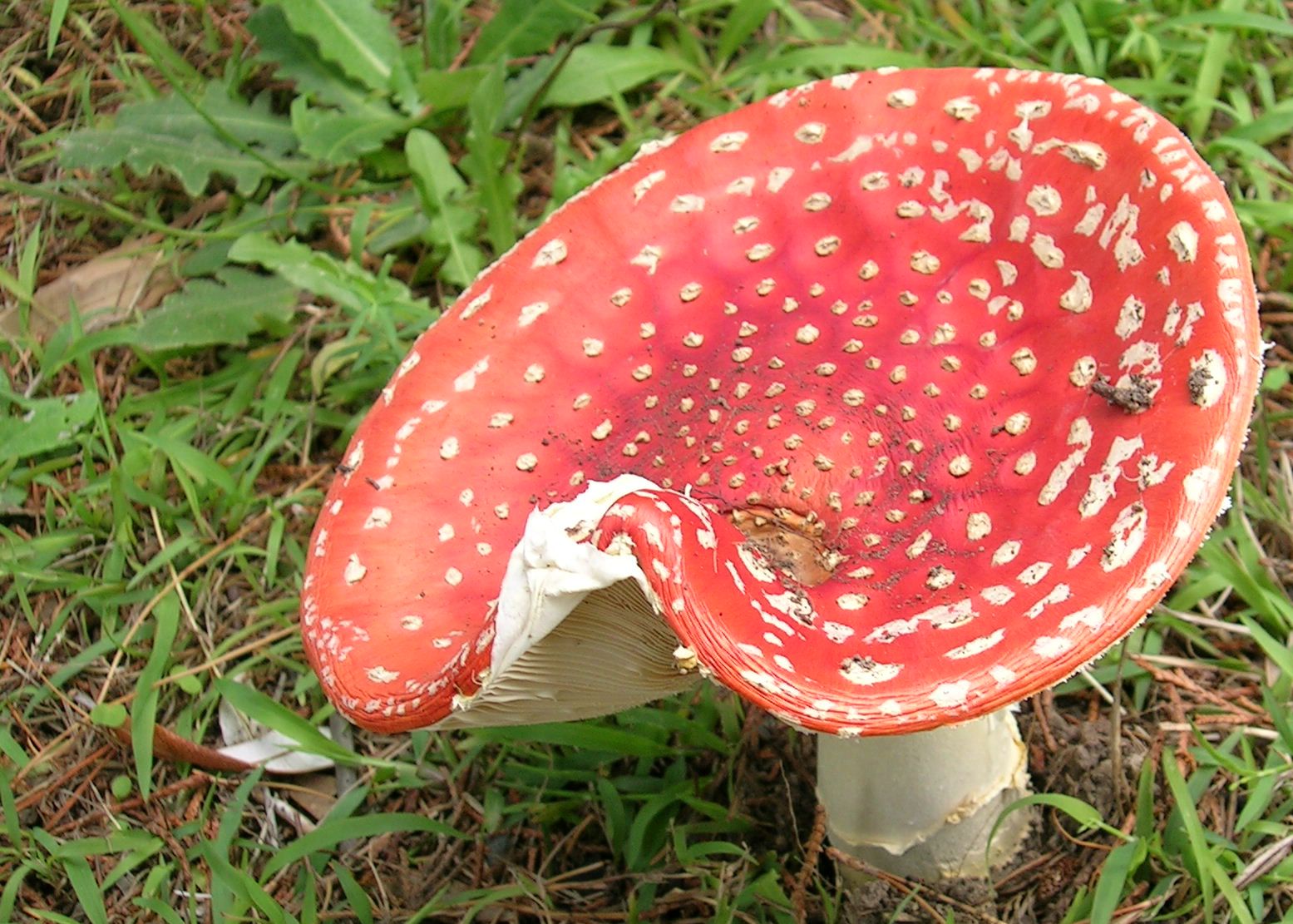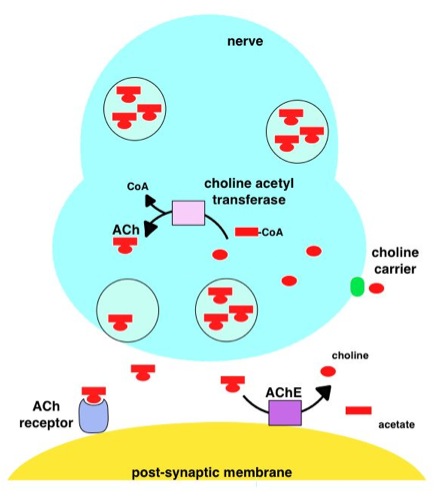|
Muscarinic Agonist
A muscarinic agonist is an agent that activates the activity of the muscarinic acetylcholine receptor. The muscarinic receptor has different subtypes, labelled M1-M5, allowing for further differentiation. Clinical significance M1 M1-type muscarinic acetylcholine receptors play a role in cognitive processing. In Alzheimer disease (AD), amyloid formation may decrease the ability of these receptors to transmit signals, leading to decreased cholinergic activity. As these receptors themselves appear relatively unchanged in the disease process, they have become a potential therapeutic target when trying to improve cognitive function in patients with AD. A number of muscarinic agonists have been developed and are under investigation to treat AD. These agents show promise as they are neurotrophic, decrease amyloid depositions, and improve damage due to oxidative stress. Tau-phosphorylation is decreased and cholinergic function enhanced. Notably several agents of the AF series of ... [...More Info...] [...Related Items...] OR: [Wikipedia] [Google] [Baidu] |
Muscarine
Muscarine, L-(+)-muscarine, or muscarin is a natural product found in certain mushrooms, particularly in ''Inocybe'' and ''Clitocybe'' species, such as the deadly '' C. dealbata''. Mushrooms in the genera ''Entoloma'' and ''Mycena'' have also been found to contain levels of muscarine which can be dangerous if ingested. Muscarine has been found in harmless trace amounts in ''Boletus'', ''Hygrocybe'', ''Lactarius'' and ''Russula''. Trace concentrations of muscarine are also found in ''Amanita muscaria'', though the pharmacologically more relevant compound from this mushroom is the Z-drug-like alkaloid muscimol. ''A. muscaria'' fruitbodies contain a variable dose of muscarine, usually around 0.0003% fresh weight. This is very low and toxicity symptoms occur very rarely. ''Inocybe'' and ''Clitocybe'' contain muscarine concentrations up to 1.6%. Muscarine is a nonselective agonist of the muscarinic acetylcholine receptors. History The name ''muscarine'' derives from that o ... [...More Info...] [...Related Items...] OR: [Wikipedia] [Google] [Baidu] |
Pilocarpine
Pilocarpine is a medication used to reduce pressure inside the eye and treat dry mouth. As eye drops it is used to manage angle closure glaucoma until surgery can be performed, ocular hypertension, primary open angle glaucoma, and to bring about constriction of the pupil following its dilation. However, due to its side effects it is no longer typically used in the long term management. Onset of effects with the drops is typically within an hour and lasts for up to a day. By mouth it is used for dry mouth as a result of Sjögren syndrome or radiation therapy. Common side effects of the eye drops include irritation of the eye, increased tearing, headache, and blurry vision. Other side effects include allergic reactions and retinal detachment. Use is generally not recommended during pregnancy. Pilocarpine is in the miotics family of medication. It works by activating cholinergic receptors of the muscarinic type which cause the trabecular meshwork to open and the aqueous humor to ... [...More Info...] [...Related Items...] OR: [Wikipedia] [Google] [Baidu] |
COPD
Chronic obstructive pulmonary disease (COPD) is a type of progressive lung disease characterized by long-term respiratory symptoms and airflow limitation. The main symptoms include shortness of breath and a cough, which may or may not produce mucus. COPD progressively worsens, with everyday activities such as walking or dressing becoming difficult. While COPD is incurable, it is preventable and treatable. The two most common conditions of COPD are emphysema and chronic bronchitis and they have been the two classic COPD phenotypes. Emphysema is defined as enlarged airspaces (alveoli) whose walls have broken down resulting in permanent damage to the lung tissue. Chronic bronchitis is defined as a productive cough that is present for at least three months each year for two years. Both of these conditions can exist without airflow limitation when they are not classed as COPD. Emphysema is just one of the structural abnormalities that can limit airflow and can exist without airflow ... [...More Info...] [...Related Items...] OR: [Wikipedia] [Google] [Baidu] |
Asthma
Asthma is a long-term inflammatory disease of the airways of the lungs. It is characterized by variable and recurring symptoms, reversible airflow obstruction, and easily triggered bronchospasms. Symptoms include episodes of wheezing, coughing, chest tightness, and shortness of breath. These may occur a few times a day or a few times per week. Depending on the person, asthma symptoms may become worse at night or with exercise. Asthma is thought to be caused by a combination of genetic and environmental factors. Environmental factors include exposure to air pollution and allergens. Other potential triggers include medications such as aspirin and beta blockers. Diagnosis is usually based on the pattern of symptoms, response to therapy over time, and spirometry lung function testing. Asthma is classified according to the frequency of symptoms, forced expiratory volume in one second (FEV1), and peak expiratory flow rate. It may also be classified as atopic or non-atopic, ... [...More Info...] [...Related Items...] OR: [Wikipedia] [Google] [Baidu] |
Bronchial Hyperreactivity
Bronchial hyperresponsiveness (or other combinations with airway or hyperreactivity, BH used as a general abbreviation) is a state characterised by easily triggered bronchospasm (contraction of the bronchioles or small airways). Bronchial hyperresponsiveness can be assessed with a bronchial challenge test. This most often uses products like methacholine or histamine. These chemicals trigger bronchospasm in normal individuals as well, but people with bronchial hyperresponsiveness have a lower threshold. Bronchial hyperresponsiveness is a hallmark of asthma but also occurs frequently in people with chronic obstructive pulmonary disease (COPD). In the Lung Health Study, bronchial hyperresponsiveness was present in approximately two-thirds of patients with non-severe COPD, and this predicted lung function decline independently of other factors. In asthma it tends to be reversible with bronchodilator A bronchodilator or broncholytic (although the latter occasionally includes secretory ... [...More Info...] [...Related Items...] OR: [Wikipedia] [Google] [Baidu] |
Methacholine
Methacholine (International Nonproprietary Name, INN, United States Adopted Name, USAN) (trade name Provocholine), also known as Acetyl-β-methylcholine, is a synthetic choline ester that acts as a non-selective muscarinic receptor agonist in the parasympathetic nervous system. Medical uses Methacholine is primarily used to diagnose bronchial hyperreactivity, which is the hallmark of asthma and also occurs in chronic obstructive pulmonary disease. This is accomplished through the bronchial challenge test, or methacholine challenge, in which a subject inhales aerosolized methacholine, leading to bronchoconstriction. Other therapeutic uses are limited by its adverse cardiovascular effects, such as bradycardia and hypotension, which arise from its function as a acetylcholine, cholinomimetic. Pharmacology It is highly active at all of the muscarinic receptors, but has little effect on the nicotinic receptors. Methacholine has a charged quaternary amine structure, rendering it in ... [...More Info...] [...Related Items...] OR: [Wikipedia] [Google] [Baidu] |
Carbachol
Carbachol, also known as carbamylcholine and sold under the brand name Miostat among others, is a cholinomimetic drug that binds and activates acetylcholine receptors. Thus it is classified as a cholinergic agonist. It is primarily used for various ophthalmic purposes, such as for treating glaucoma, or for use during ophthalmic surgery. It is generally administered as an ophthalmic solution (i.e., eye drops). Carbachol produces effects comparable to those of sarin if a massive overdose is administered (as may occur following industrial and shipping accidents) and therefore it is classified as an extremely hazardous substance in the United States as defined in Section 302 of the U.S. Emergency Planning and Community Right-to-Know Act (42 U.S.C. 11002), and is subject to strict reporting requirements by facilities which produce, store, or use it in significant quantities. It is on the World Health Organization's List of Essential Medicines. Chemistry and pharmacology Carbach ... [...More Info...] [...Related Items...] OR: [Wikipedia] [Google] [Baidu] |
Acetylcholine
Acetylcholine (ACh) is an organic chemical that functions in the brain and body of many types of animals (including humans) as a neurotransmitter. Its name is derived from its chemical structure: it is an ester of acetic acid and choline. Parts in the body that use or are affected by acetylcholine are referred to as cholinergic. Substances that increase or decrease the overall activity of the cholinergic system are called cholinergics and anticholinergics, respectively. Acetylcholine is the neurotransmitter used at the neuromuscular junction—in other words, it is the chemical that motor neurons of the nervous system release in order to activate muscles. This property means that drugs that affect cholinergic systems can have very dangerous effects ranging from paralysis to convulsions. Acetylcholine is also a neurotransmitter in the autonomic nervous system, both as an internal transmitter for the sympathetic nervous system and as the final product released by the parasymp ... [...More Info...] [...Related Items...] OR: [Wikipedia] [Google] [Baidu] |
Acetylcholinesterase
Acetylcholinesterase (HGNC symbol ACHE; EC 3.1.1.7; systematic name acetylcholine acetylhydrolase), also known as AChE, AChase or acetylhydrolase, is the primary cholinesterase in the body. It is an enzyme Enzymes () are proteins that act as biological catalysts by accelerating chemical reactions. The molecules upon which enzymes may act are called substrates, and the enzyme converts the substrates into different molecules known as products. A ... that catalysis, catalyzes the breakdown of acetylcholine and some other choline esters that function as neurotransmitters: : acetylcholine + H2O = choline + acetate It is found at mainly neuromuscular junctions and in chemical synapses of the cholinergic type, where its activity serves to terminate neurotransmission, synaptic transmission. It belongs to the carboxylesterase family of enzymes. It is the primary target of inhibition by organophosphorus compounds such as nerve agents and pesticides. Enzyme structure and mechani ... [...More Info...] [...Related Items...] OR: [Wikipedia] [Google] [Baidu] |
Dry Mouth
Xerostomia, also known as dry mouth, is dryness in the mouth, which may be associated with a change in the composition of saliva, or reduced salivary flow, or have no identifiable cause. This symptom is very common and is often seen as a side effect of many types of medication. It is more common in older people (mostly because this group tend to take several medications) and in persons who breathe through their mouths. Dehydration, radiotherapy involving the salivary glands, chemotherapy and several diseases can cause reduced salivation (hyposalivation), or a change in saliva consistency and hence a complaint of xerostomia. Sometimes there is no identifiable cause, and there may sometimes be a psychogenic reason for the complaint. Definition Xerostomia is the subjective sensation of dry mouth, which is often (but not always) associated with hypofunction of the salivary glands. The term is derived from the Greek words ξηρός (''xeros'') meaning "dry" and στόμα (''stoma'') ... [...More Info...] [...Related Items...] OR: [Wikipedia] [Google] [Baidu] |
Approved Drug
An approved drug is a medicinal preparation that has been validated for a therapeutic use by a ruling authority of a government. This process is usually specific by country, unless specified otherwise. Process by country United States In the United States, the FDA approves drugs. Before a drug can be prescribed, it must undergo the FDA's approval process. While a drug can feasibly be used off-label (for non-approved indications), it still is required to be approved for a specific disease or medical condition. Drug companies seeking to sell a drug in the United States must first test it. The company then sends the Food and Drug Administration's Center for Drug Evaluation and Research (CDER) evidence from these tests to prove the drug is safe and effective for its intended use. A fee is required to make such FDA submission. For financial year 2020, this fee was: for an application requiring clinical data ($2,942,965) and for an application not requiring clinical data ($1,471,4 ... [...More Info...] [...Related Items...] OR: [Wikipedia] [Google] [Baidu] |


